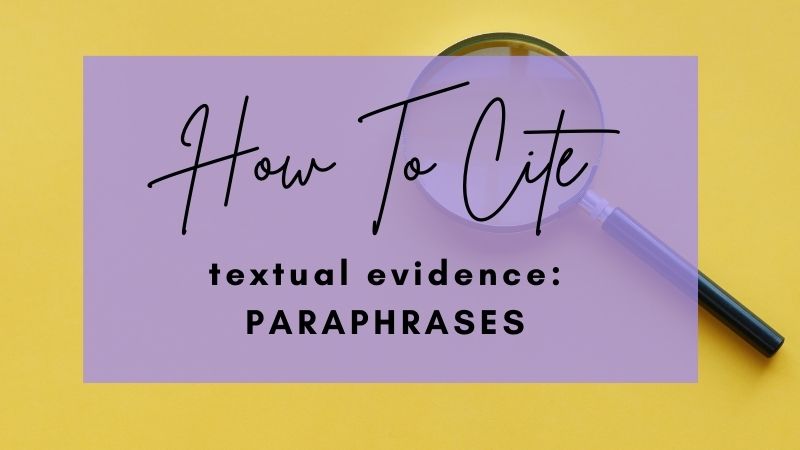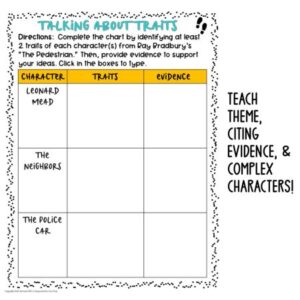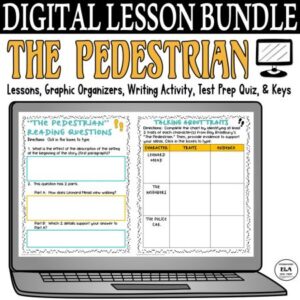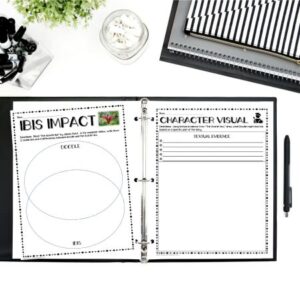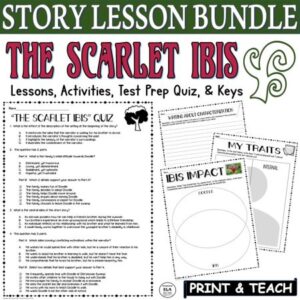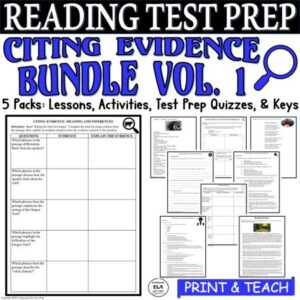One of the capstones of most reading comprehension standards is to CITE TEXTUAL EVIDENCE! Every answer needs support!
Unfortunately, most students struggle with citing evidence, especially when it comes to PARAPHRASING. They might know an answer because they understand the central idea or the main topic. Or they can make a basic inference. Many, however, don’t understand the need for citing textual evidence.
And really, this skill is key to pretty much any area of comprehension, analysis, and argument. Because we need to actually substantiate what we believe, we MUST teach our students how to cite textual evidence before pretty much any other standard!
Keep reading below to get ideas for teaching students How to Cite Textual Evidence: Paraphrases!
Need help with Test Prep? Check out this FREE Pack of 3 Test Prep Activities to help students achieve success on standardized tests!

3 Characteristics of GOOD Evidence!
- Relevant: The evidence should directly support the answer to the question. If there is better evidence, then students need to learn to choose the BEST evidence possible. And the toughest part is the time it takes to find the best support. Patience is vital. Students need to practice rereading, skimming, and annotating, so they can locate the best and most relevant textual support.
- Specific: Sometimes, the evidence is vague. Vague is a no-go. The textual evidence might still be relevant and related, yet it might not be specific enough to connect to the student’s response. The more specific, the better. Think about our world today. People are lazy and/or uninformed, and instead of doing the hard work of researching, they are content to know generalities. As teachers, we can help our students become critical thinkers who know the facts and the actual research! Specificity is necessary when teaching our kids how to cite textual evidence!
- Essential: We only need to cite the evidence that is the most essential. I don’t know about you, but in college, I had a ton of professors who had a word or page limit. Because of this requirement, I was tempted to use a longer sentence or even a full paragraph in a paper. Let’s be real. We have all tried to extend our papers with evidence. We know this practice is not the best, so we need to teach our students to only use the detail, word, phrase, or sentence that is essential. When we cite, we may only need one, two, or ten words to prove our point. This use of evidence is good practice for the real world, where most people appreciate brevity. Substantiate your claim and move on!
Paraphrasing Textual Evidence
Paraphrases should NOT be word for word the same as the text itself, and they should NOT be long-winded summaries. We also do not want “Synonym Ninjas,” who literally replace every word with a synonym. This practice leads to sentences that just don’t make a complete, logical sentence. (Ex. I love cats. >>> Ex. Individual appreciates felines.) A paraphrase should be a rewording of the evidence with the meaning still intact.
Here is an activity for practicing how to cite textual evidence based on “The Pedestrian” by Ray Bradbury!
Directions: Complete the chart by identifying at least 2 traits of each character(s) from “The Pedestrian” by Ray Bradbury. Then, provide evidence to support your ideas.
*Note: Every piece of evidence is paraphrased and directly correlates to the student’s response in the TRAITS category.
| CHARACTER | TRAITS | EVIDENCE |
| Leonard Mead | Ex. Creative
Ex. Isolated Ex. Knowledgeable |
Ex. He creates visions in his head about his surroundings.
Ex. He walks alone every night. Ex. He is a writer who values things beyond mere television entertainment. |
Notice, we are asking students to cite textual evidence, BUT they can use paraphrases based on the direct quote! This requires MUCH higher level thinking, which is what we ultimately want.
Here is a sample 2-Part Question for the short story “The Pedestrian” by Ray Bradbury!
This question has 2 parts.
Part A: How does Leonard Mead view walking?
A. He sees it as pleasurable, yet unconventional.
B. He sees it as melancholic, yet peaceful.
C. He sees it as enjoyable, yet terrifying.
D. He sees it as humorous, yet exciting.
Part B: Which 2 details support your answer to Part A?
□ He is walking alone while others are staying inside their homes.
□ He is walking to get out and look at various sights around him.
□ He is walking to have some alone time away from his family.
□ He is walking to increase his amount of oxygen intake.
□ He is walking instead of going to work every day.
□ He is walking to learn about his neighbors.
Want readymade PDF and digital resources that encourage students to cite textual evidence for “The Pedestrian” by Ray Bradbury? Click below!
How to CITE TEXTUAL EVIDENCE in various ways:

Citing Paraphrases:
The ONLY difference between citing paraphrases and citing direct textual evidence is that you don’t need quotation marks. Remember, the details from the text are in your own words. That is it! Yes, you still need to mention the author/speaker and the title. And, for a research paper, you will need to include the APA or MLA formatting as well as a Works Cited entry. A paraphrase is based on someone else’s ideas, so a citation is necessary! Teaching our students how to cite textual evidence as a paraphrase is so helpful in avoiding plagiarism.
1. Citations for a Literary Analysis or Informational Paired Passage Response with 1 or more texts
***You need to include the author and the title before students cite textual evidence….***
Here is an example from James Hurst’s “The Scarlet Ibis” Activity Pack!
Short Response: How is Doodle similar to the ibis? What is the meaning of this connection between Doodle and the ibis? Use evidence to support your ideas.
2. Citations for a Research Paper or Rhetorical Analysis Essay with 1 or more texts
-
- You will want to mention the author’s last name within the sentence or at the end of the sentence along with the title of the article.
- Ex. Bill Miller from the article “10 Steps to a Better You” claims that people should work out a minimum of an hour per day.
- Ex. In the article “10 Steps to a Better You,” Bill Miller writes that people should work out a minimum of an hour per day.
- Ex. The article “10 Steps to a Better You” outlines that people should work out a minimum of an hour per day (Miller).
- You will want to mention the author’s last name within the sentence or at the end of the sentence along with the title of the article.
-
- If there is no author’s name mentioned, the title of the article should be included.
- Ex. The article “10 Steps to a Better You” relays that people should work out a minimum of an hour per day.
- Ex. Some assert that people should work out a minimum of an hour per day (“10 Steps to a Better You”).
- If there is no author’s name mentioned, the title of the article should be included.
Need to teach how to cite textual evidence for a rhetorical analysis essay? Click the image below to get help teaching rhetorical analysis for ANY text!
*Check out OWL Purdue for more specifics regarding research paper citations!
Click here to read about How To Cite Textual Evidence for Direct Quotes!
The Importance of Teaching How To Cite Textual Evidence
More than anything, we want our students to be successful not just in our own classrooms but in the world beyond. They might choose to go to college. In any academic arena, professors will assign them tasks that will require students to cite textual evidence. Teaching them how to cite textual evidence repeatedly and offering our kiddos consistent practice will help in mastering this important skill! Even if they don’t go to college or write another paper beyond high school, we want to empower our students to not merely accept a basic summary of someone else’s ideas.
Instead, we want them to become critical thinkers and debaters who do research, find evidence, and cite their sources for anything they are passionate about. This process will enable our students to become citizens who are critical and analytical; they will have something to say and actually know how to support their ideas with FACTS!
We should NOT rely on others to tell us what we need to know. We need to think for ourselves and support all of our ideas with relevant, specific, and essential evidence at all times!
For more activities, quizzes, and lesson ideas that include how to cite textual evidence, check out my store Integrated ELA Test Prep!
Need help with Test Prep? Check out this FREE Pack of 3 Test Prep Activities to help students achieve success on standardized tests!

